265 vs 275 Tire: Find Winner Based On 6 Parameter Comparison
The dilemma of 265 vs 275 tire sizes often leaves drivers wondering which option is the best fit. Choosing the right tires for your vehicle is crucial for safety, performance, and overall driving experience. Today, we will tackle this problem head-on, providing you with the knowledge and insights needed to make an informed decision.
Let’s learn the differences between the duo, their highlights, and performance variation, and find the winner. Also, we will do a little dive into reading the numbers, and when to change the tire!
Table of Contents
Exploring 265 and 275 Tires
When it comes to selecting the right tires for your vehicle, understanding the nuances between different sizes is crucial. Two popular options that often spark debate among car enthusiasts are the 265 and 275 tires.
These numbers represent the width of the tire in millimeters. They can have a significant impact on your vehicle’s performance and handling. Let’s take a look at both of these tires:
265 Tire
It refers to a specific tire size commonly used in the automotive industry. The number 265 is the tire tread measured in millimeters.

- A 265 tire is a wider tire when you compare it to a 255.
- The wider tread width provides a larger contact patch with the road surface.
- It contributes to improved traction and stability during acceleration and cornering maneuvers.
- The increased surface area allows for more grip, particularly in dry conditions.
- It enhances the vehicle’s ability to maintain control and responsiveness.
It’s important to note that tire width is just one factor among many that influence a tire’s performance. Other factors such as the tread pattern, rubber compound, and construction also play a crucial role.
275 Tire
When it comes to tires for large vehicles, 275 ones are quite popular. They may look similar to 265 at first glance, but they have a bigger diameter. To make things easier for customers, sizes are displayed to indicate the appropriate rim size for each tire.

Typically, a 275 tire requires an 18-inch rim. But if you have a larger vehicle, you can choose even bigger rims.
- What makes 275 tires appealing is that they are great for those who enjoy driving at higher speeds.
- In fact, these tires can make your car go approximately 1.5 mph faster than what the speedometer shows.
- They are also beneficial for RV or motorhome owners as they provide better mileage during long trips.
- It’s important to note that 275 tires tend to be more expensive than 265 tires.
If you don’t frequently drive long distances and you don’t drive an RV, opting for 265 tires might be more cost-effective.
Still unsure about which tire is the right choice for you, let’s dive further and discuss the specific factors that make sense for your needs.
A Quick Sneak Peek At Both Options: 275 vs 265 Car Tires
Let’s explore what set these tires apart:
Parameter | 265 | 275 | Difference |
Section WidthSection Width: | 10.4 inch | 10.8 inch | +0.4 inch (+3.8%) |
Diameter: | 31.6 inch | 32.2 inch | +0.6 inch (+1.7%) |
Circumference: | 99.3 inch | 101 inch | +1.7 inch (+1.7%) |
Revs/Km: | 638.1 | 627.2 | -10.9 (-1.7%) |
Sidewall Height: | 7.3 inch | 7.6 inch | +0.3 inch (+3.8%) |
Aspect Ratio: | 70 | 70 | 0 (0%) |
Now, it’s time to check out the differences between both tires.
Decoding the Differences
Now, let’s compare both tires based on various parameters to gain a comprehensive understanding of their similarities and differences.
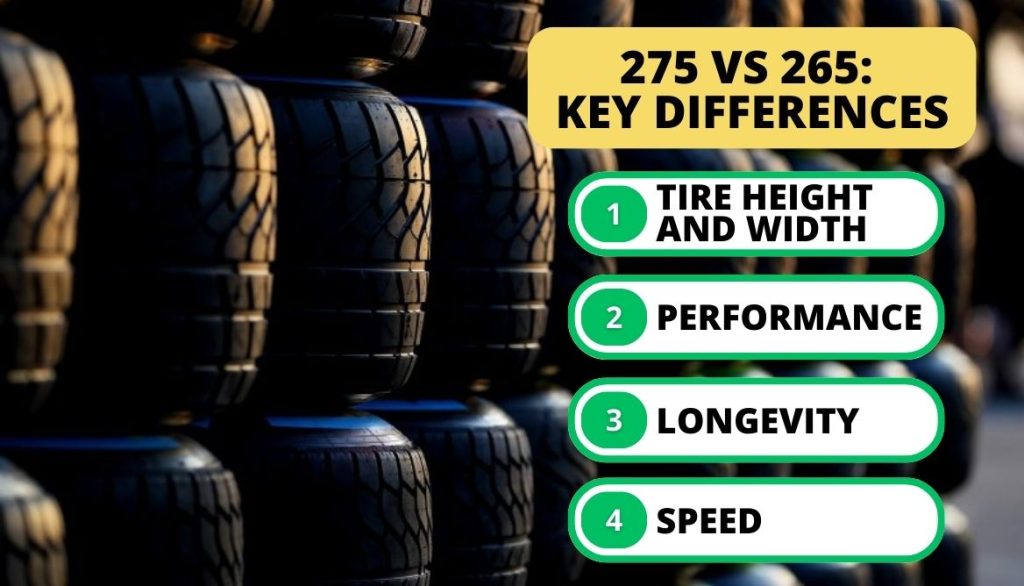
1. Tire Height
Considering the height of both tires, the difference between them is relatively small. The 275 is a taller tire at around 32.2 inches, while the 265 tire measures approximately 31.6 inches in height.
Performance Difference
In terms of performance, both tires have their benefits. You get a more comfortable experience with the 265s due to better absorption of bumps and vibrations while a 275 provides better handling because of a larger contact patch. It also varies depending on the vehicle you are driving. The speedometer readings may be lower or higher than your actual speed.
Tire Longevity
Due to the taller height of the 275 tire, it tends to have fewer revolutions per mile compared to its counterpart. This is advantageous for tire longevity.
The disparity in height between these tires is minimal. But the reduced contact area with the road surface leads to slower wear and potentially longer-lasting tires.
Winner: The difference isn’t noticeable during regular driving with either of these tires. But 275 tires tend to last longer so they are the clear winner.
2. Tire Width
The 275 tire is wider than its counterpart, but the difference is not significant. It’s only a 0.4-inch variation, which is similar to upgrading from 16-inch 275 tires to 17-inch ones.
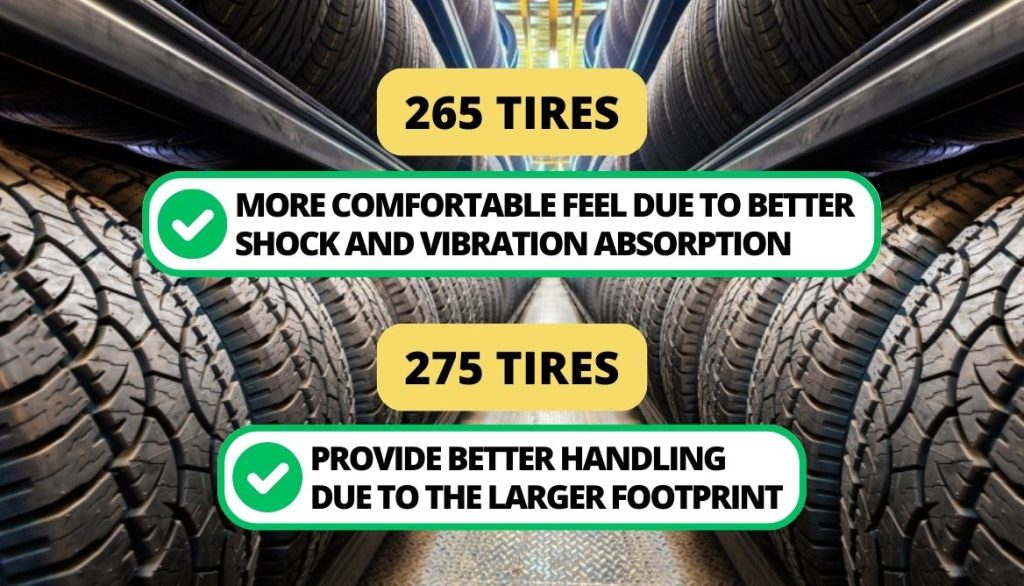
Although this small difference is unlikely to greatly affect fuel efficiency, it’s worth noting that thicker tires may be more susceptible to hydroplaning. This is when due to water, the tires lose grip and the vehicle starts to slide on the water.
Thinner & Thicker Tires
Thinner tires tend to handle wet conditions and slippery roads, including those with puddles, better than thicker ones. Driving on wet grass or clay-like surfaces, the 265 tire outperforms the 275.
Thicker tires generally provide less traction on most surfaces, except for pavement and deep sand.
Speed Difference
Discussing the speed, the 275 tires show a slight increase of just over 1 mph compared to the speedometer reading. This discrepancy can make a significant impact when approaching speed traps. Therefore, you should be always aware of your current speed.
Winner: There is no clear winner in the speed category. However, 265 has a little more control on wet grass surfaces and an edge in the competition!
3. The Bigger One In the Competition
The 275 tire is slightly larger than its competition in various measurements.
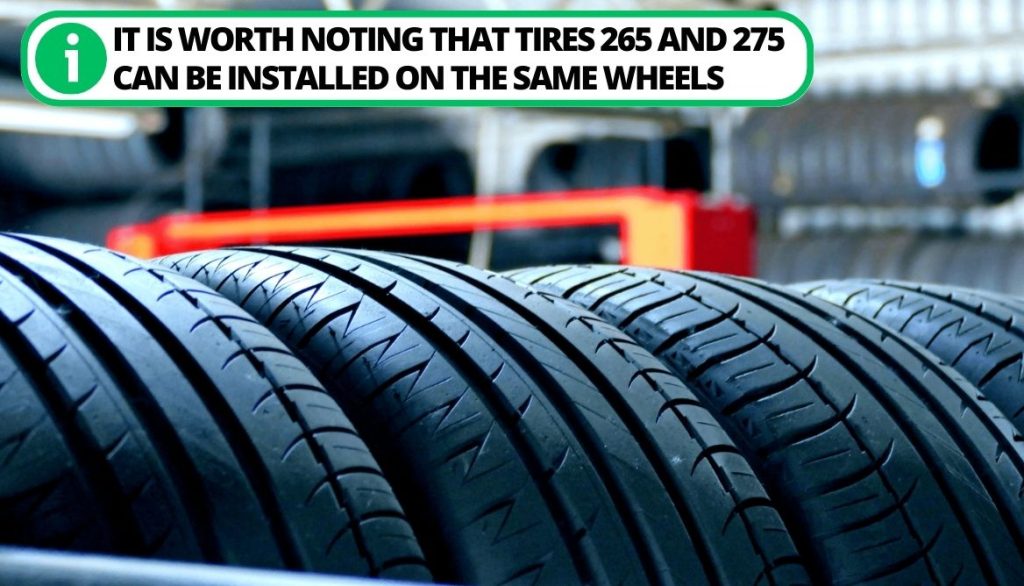
- The section width of the 275 tire measures 10.8 inches compared to the 10.4 inches of the 265 tire.
- The overall diameter of the 275 is 32.2 inches, while its counterpart measures 31.6 inches.
- When it comes to sidewall height, the 275 tire surpasses its counterpart, with a measurement of 7.6 inches compared to the 7.3 inches of the 265 tire.
- In terms of circumference, the 275 measures 101 inches, slightly larger than the 99.3 inches of the 265.
- The only aspect where the 265 is ahead of the 275 is in revolutions per mile.
- The 275 registers 627.2 revolutions per mile compared to the 638.1 revolutions per mile of the 265.
However, it’s worth noting that despite these small differences, both tires can fit on the same rims. Therefore, even if you upgrade your rim size from a 16 or 17-inch to an 18-inch rim, the 275 still remains the larger tire size.
Now, let’s see if both of these tires can be interchanged.
Can You Interchange Both of Them
This question’s answer can be yes or no, depending on certain factors.
If you are changing all tires on your car simultaneously, you can replace four tires of 265 with four 275 tires without compromising performance or safety.
Never Mix-Match Tires
However, it is generally not advisable to use different tire sizes on a vehicle.
- If you replace only one tire with a different size, it can lead to potential performance and safety concerns.
- It is recommended to avoid combining radial tires with different load-carrying capacities and speed ratings on the same vehicle.
- Maintaining consistency in tire sizes, types, and specifications helps ensure optimal performance, handling, and safety.
Let’s head toward the importance of numbers on tires.
265 vs 275 Tires: How Numbers Influence Performance
Let’s take a look at how differences between 265 vs 275 tires values numbers affect performance:

1. Revolutions Per Mile
275 tires have 10 fewer revolutions per mile compared to 265 tires. This means that the engine runs with reduced efficiency and MPG due to the lower RPM. As a result, you end up spending more on gas and maintenance expenses.
2. Speedometer Reading
The larger diameter of the 275 tires leads to a slight inaccuracy in speedometer readings. Specifically, the speedometer may show a deviation of around 1.7% when using 275 radial tires. This small difference is nothing to be concerned about.
3. Vehicle Height
The circumference of 275 tires is approximately 1.7% larger than that of 265 tires. This translates to a difference of around 0.3 inches in the vehicle clearance. When replacing tires, it is generally recommended to maintain a maximum difference of 3% in diameter and height between the old and new tires.
Reading the Numbers on the Tire
You must’ve seen the number on your radial tire. Have you ever thought about the meaning of that specific number? Every driver should know how to read the numbers on all four tires.
215/Section Width
This is where the number starts from. It shows your tire measurement in millimeters. It is the point from the sidewall of the tire to where it joins the rim until the tread.
60/Aspect Ratio
The sidewall height of a tire is expressed as a percentage of its tread width. An aspect ratio of 70 means that the section height of the tire is 70% of the section width.
R/Construction Type
R represents the radial construction. Many tires also contain the letter B which implies a cross-ply structure. But radial tires are more popular.
17/Rim Diameter
This shows the interior diameter of the tire. It indicated the height or diameter and is measured in inches.
7 Signs Indicating Tire Replacement
Listed below are seven different methods you can use for a tire inspection. Let’s check them out!
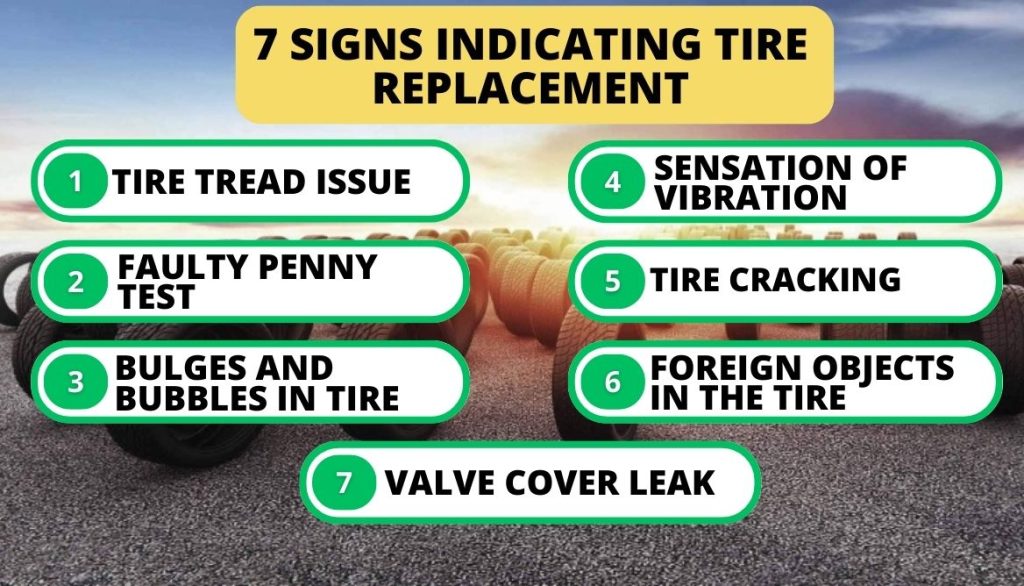
1. Visual Inspection
The first thing is to visually analyze the tire using the steps listed below:
- Inspect the tire tread to verify its depth and uniform wear.
- Examine the tires for treadwear indicators or “wear bars,” which are present in all DOT-regulated tires. These markers will align with the tread surface when the tread depth reaches two-thirds of an inch.
- Inspect the sidewalls of each tire for any visible signs of damage.
2. Penny Test
You can also opt for a penny test to assess your tire. Listed below are the important steps to follow:
- Enter the penny into the tread of the tire.
- Make sure that Lincoln’s head is pointing downwards into the tread.
- If the top of Lincoln’s head is hidden, your tread depth is still above the 2/32″ mark, and your tire is good to go.
- If Lincoln’s full head is visible, it is best to opt for new tires because the tread is too shallow.
- Check all four tires, paying extra attention to the areas that appear most worn.
For further information, you can watch this short video.
3. Bubbles And Bulges
Checking for a bulge in the tire allows you to assess its condition actively.

- If you notice a bulge in the tire, it indicates a break in its internal frame. It allows air pressure to reach the outer layers.
- No matter the state of the tread, it is crucial to promptly replace any tire.
4. Vibration
You might also experience vibrations if the tires are in poor condition. This indicates the need for a tire change.
- Unevenly worn tires can generate vibrations that can be felt through the steering wheel.
- Misalignment of the tires is another factor that can contribute to vibrations.
- To identify the root cause, it is advisable to seek assistance from a tire professional.
5. Cracks On The Sidewall
If the sidewall is cracking, then it is most commonly due to the aging tire.

- Exposure to extreme conditions over time can lead to rubber degradation.
- Cracking can occur even when tires are not in use or stored in a safe location.
- Common causes of cracking include sunlight, high heat, road chemicals, and ozone exposure.
- Cuts in tires are typically a result of forceful impact with hard objects.
6. Embedded Stones in Radial Tire
Always make sure to check your tires for any debris or stones. A lot of times, nails and stones get stuck in the tire and make a hole.
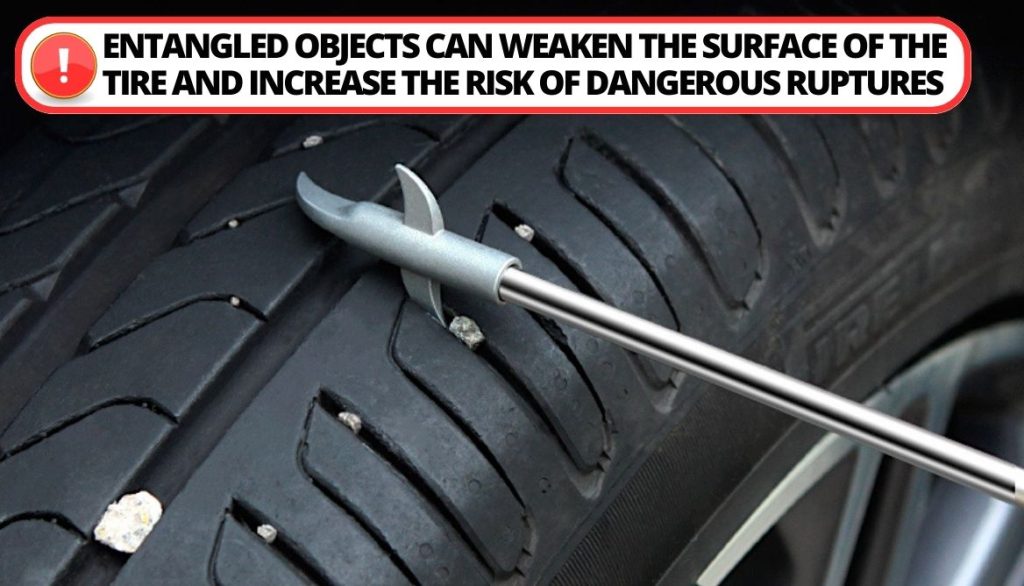
- Promptly fix any objects stuck in the tire, even if the hole isn’t causing significant leakage.
- Ignoring a hole, such as one caused by a nail, can lead to future difficulties for the driver.
- Moisture can enter the tire through the hole and cause rusting of the steel components.
- Lodged objects can weaken the tire’s area and increase the risk of dangerous blowouts if not addressed in a timely manner.
7. Broken Valve Caps
You should always keep the valve cap tightened. Remember the following things:
- If the cap cannot be tightened adequately, it will keep loosening.
- Excessive tightening of the cap can damage the thread on the stem.
- A leaking valve cover can allow dirt, moisture, and debris to enter the tire.
Note: It is better to contact a local tire dealer about wearing or broken valves as they tend to have more experience.
For more insights, check out this helpful video.
How Different Tire Types Affect Performance
You should also know that different types of tires also affect performance.
- Summer tires are best at providing great handling in dry conditions.
- Winters ones are superb at dealing with snow and ice.
- All-season tires are the most versatile. You can use them in all conditions.
- The off-road type is best at dealing with uneven terrain.
If you are looking for more detailed information, watch this video.
5 Helpful Tips for Selecting the Correct Width
Here are some tips to help you in choosing the correct width:
- Pick the tire based on the rim diameter to ensure a proper fit.
- Take the help of a tire size calculator to assess the aspect ratio of the tire with the rim diameter.
- Go through all the guidelines and requirements from the wheel manufacturers.
- Ensure that the wheels can make a full 360-degree rotation after tire replacement.
- Make sure that all tires are either Radial or Bias type.
FAQ
Can I replace 265 tires with 275?
Yes, you can replace 265 tires with 275 tires. It is only possible to replace the two tires as long as they are compatible with your vehicle’s rim size.
Is 275 a wide TYRE?
275 is considered a wide tire. It has a larger section width compared to standard same tires.
How tall is a 275 tire?
A 275 tire typically has a height or diameter of approximately 31.6 inches.
Is it OK to use different tire sizes?
Using different tire sizes can negatively impact the performance and safety of your vehicle, so it is generally not recommended. Using tires with the same aspect ratio is necessary for optimal performance and safety.
How much difference in tire size is acceptable?
The acceptable difference in tire size depends on various factors, including the vehicle’s specifications and manufacturer recommendations. It is generally advised to stay within a 3% difference in overall tire diameter to ensure optimal performance and accuracy of speedometer readings.
Conclusion
Understanding the differences between 265 and 275 tires is crucial for maintaining optimal performance and safety on the road. The 265 offers a better comfort level and improved grip on wet surfaces due to less traction. In contrast, 275 proves to be more stable at a higher speed and has a greater lifespan due to fewer revolutions.
So which one to choose between the two tires boils down to your personal preference. Either way, both are a worthy investment.
Which tires are you using on your passenger vehicle? How has your experience been so far? Share your thoughts in the comments!

I`m a current Law Enforcement Officer working within the Counterterrorism Bureau in New York State. I have been Camping for over 20 years. My styles of camping include tent, car, truck, van, and RV travel trailer. I have a YouTube channel where I teach all types of camping with an entertaining method: https://youtube.com/@TheSmallsRVAdventures

![Top 10 Best RV Water Hoses [Buying Guide]](https://camperlife.co/wp-content/uploads/2021/02/best-rv-water-hoses-768x505.jpg)
![Top 10 Best RV Wi-Fi Boosters [Detailed Reviews]](https://camperlife.co/wp-content/uploads/2021/02/best-rv-wifi-booster-768x402.png)
![Top 15 Best TV Mounts for RV [Buying Guide]](https://camperlife.co/wp-content/uploads/2021/03/best-rv-tv-mount-768x512.jpg)

![Top 8 Best RV Stabilizers [Buying Guide]](https://camperlife.co/wp-content/uploads/2021/02/best-rv-stabilizers-768x467.png)
